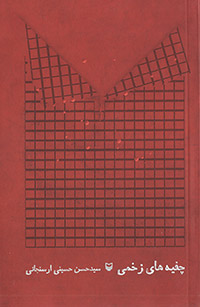“Wounded Keffiyehs” and Battles
Elham Saleh
Translated by Natalie Haghverdian
2016-05-29
“Wounded Keffiyehs” is the title of a book on eight years of Holy Defense where Commander-in-chief, Ahmad Masoudi tells his memories of the era. The book constitutes of an Introduction followed by 30 chapters and starts with his story of obtaining his father’s consent to report for duty and continues by the account of his presence in the battlefield and various operations and eventually being wounded.
The chapters, instead of titles, have numbers.
In “Wounded Keffiyeh’s” we read the memoirs of an individual introduced as “Brother Masoudi” by the author, in introduction section. His first name is unknown and it is nowhere to be found in the introduction section. However, in the Title page, his name is stated; Commander-in-chief Haj Ahmad Masoudi. Majority of the books covering the topic of the Holy Defense have a Sub-Title page which elaborates and describes the Title which is not available in this book. Biography of the narrator is not available which leaves the audience bewildering to know him.
Major account of the book is about operations carried out with no further detailed memories. The elements of appeal are not present; descriptions are simply limited to weather: “Valfajr 8 operation started and some units were in combat with the enemy. Rain was pouring.” (Chapter Fourteen), “Sun was shining hard and the enemy was firing shells every once in a while.” (Chapter Twenty Two), “The sun was cold and freezing wind was throwing ice on our face.” (Chapter Eighteen), and “It was February of 87. It was cloudy and the battlefield was covered in snow.” (Chapter Twenty Six)
General account of the events is the appealing element of the book; however these shortcomings are due to reasons that the author has defined in the Introduction: “Once I got the draft of the book from brother Masoudi, I said to myself: it needs two or three months to organize these and send it to the publisher. But when I started studying I realized that the pages are all mixed which are transcribed from tapes years ago with the handwritings of third grader and others; the notes are all scrambled and the literature is also in need of fine editing. I decided to return the drafts to the owner but when I saw Haji once again in his neck brace and broken body, I was embarrassed of myself and changed my tone and said: I’ve come here to ask your assistance to organize the transcribes and I have to bother you couple of times more to do this. Despite his physical problems, he accepted. I started my work. I introduced couple of books on Holy Defense for him to acquaint himself with the appeal. I had to travel in many occasions to Oghlid County and sit and listen to his accounts of his memories to organize the drafts to be published.”
Time passed and physical weakness of the narrator are other reasons to be considered. Hence, it is not to be considered as the weakness of the author.

Book title is an element in attracting the audience. “Wounded Keffiyehs” is successful in this aspect. It should be considered that even if the audience does not read the whole book, he would definitely read the cover and back cover of the book. The sentences selected to be printed on the back cover are the best choices. The sentences are: “Suddenly, I was suspended in the air and the sky was full of dust, quiver and soldiers. I made couple of turns in the air and couple of meters away I heat the ground. I felt like all my bones were crushed. It was dark and it was raining dust, quiver, hands and legs from sky.”
It seems like these sentences are exaggerated. They had to be in a better tone to introduce the book properly while they raise questions in the mind of the audience. They had to be presented more precisely.
Pictures and documents can be complementary elements if utilized properly. “Wounded Keffieyehs” has a chapter for pictures. 20 pictures are presented with detailed account of the image and individuals in the pictures are introduced; however, none of these efforts are sufficient. This chapter is weak; pictures are of low quality and 6 pieces are printed so black that individuals in the picture are not recognized.
A memory: Letter of Testimony
One of the elements to report for duty was to obtain the testimonial of the parents. The narrator of the book has gone through this phase which is one of the most interesting memories of the book:
I came up with an excuse and reached to the military base in Oghlid Garden and got a letter of testimony. My father trusted me and he would sign even a white check if I would ask him to. When I saw his shirt wet with sweat, I relented. I put the testimonial letter upside down on the account ledger and joined to help him. He looked at me and said: what are you doing?
- I want to help you.
A faded smile appeared on his face and said: I don’t need help … you don’t have to wheedle me.
I gave him the letter and said: then, sign this so that I can report for duty. He grabbed his greasy pen and put his big signature like an ostrich egg on the paper without reading it and said: go now!
Number of Visits: 5428
http://oral-history.ir/?page=post&id=6372
